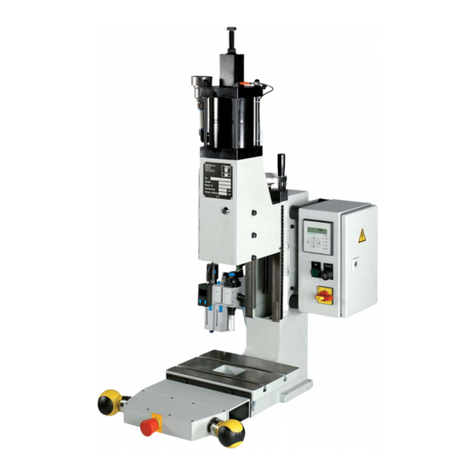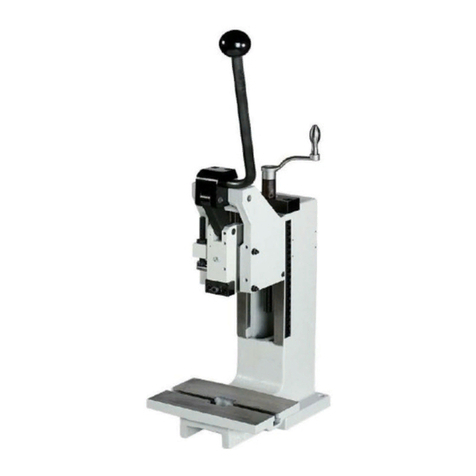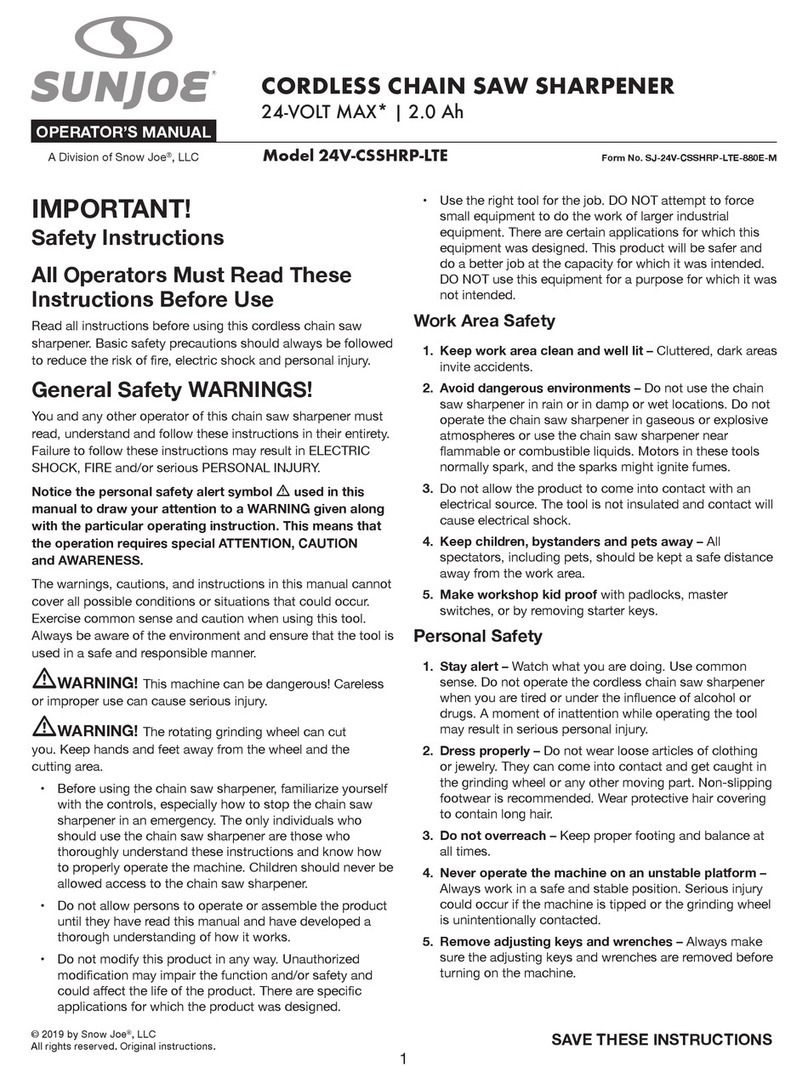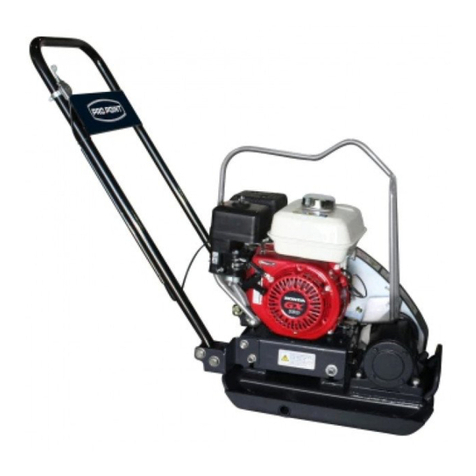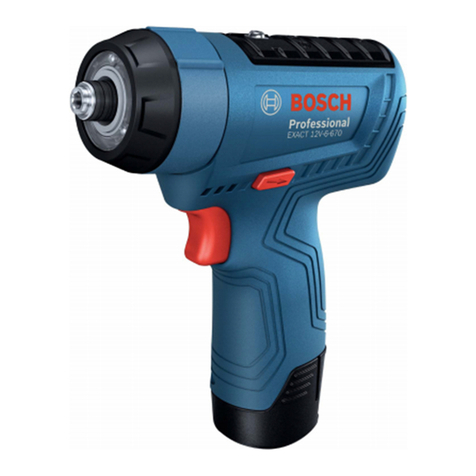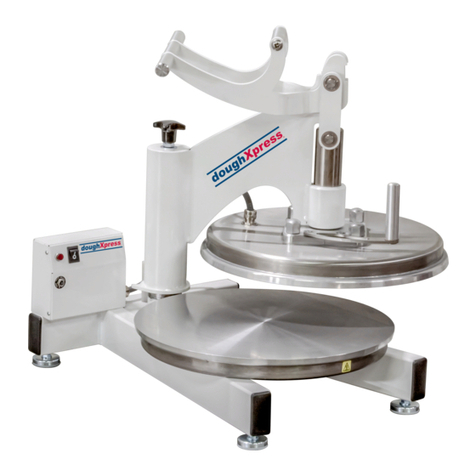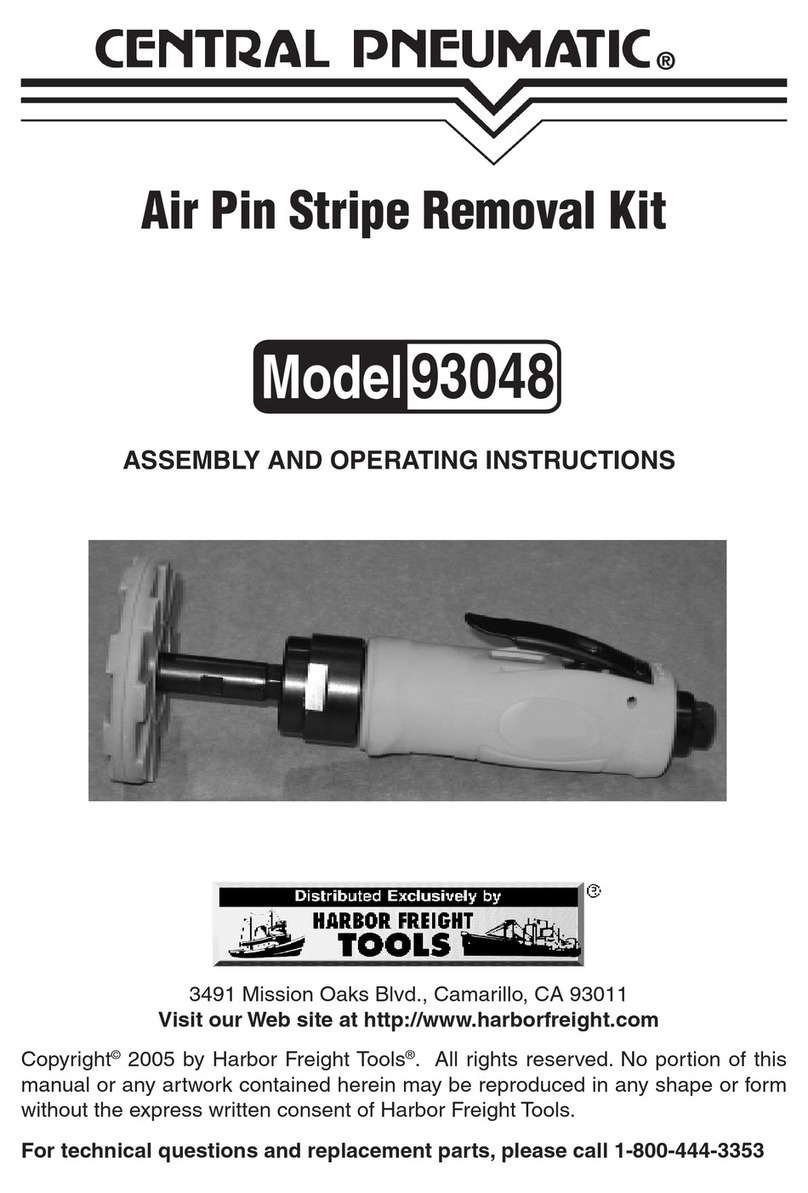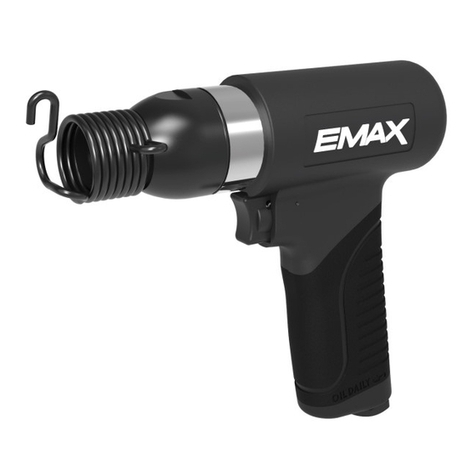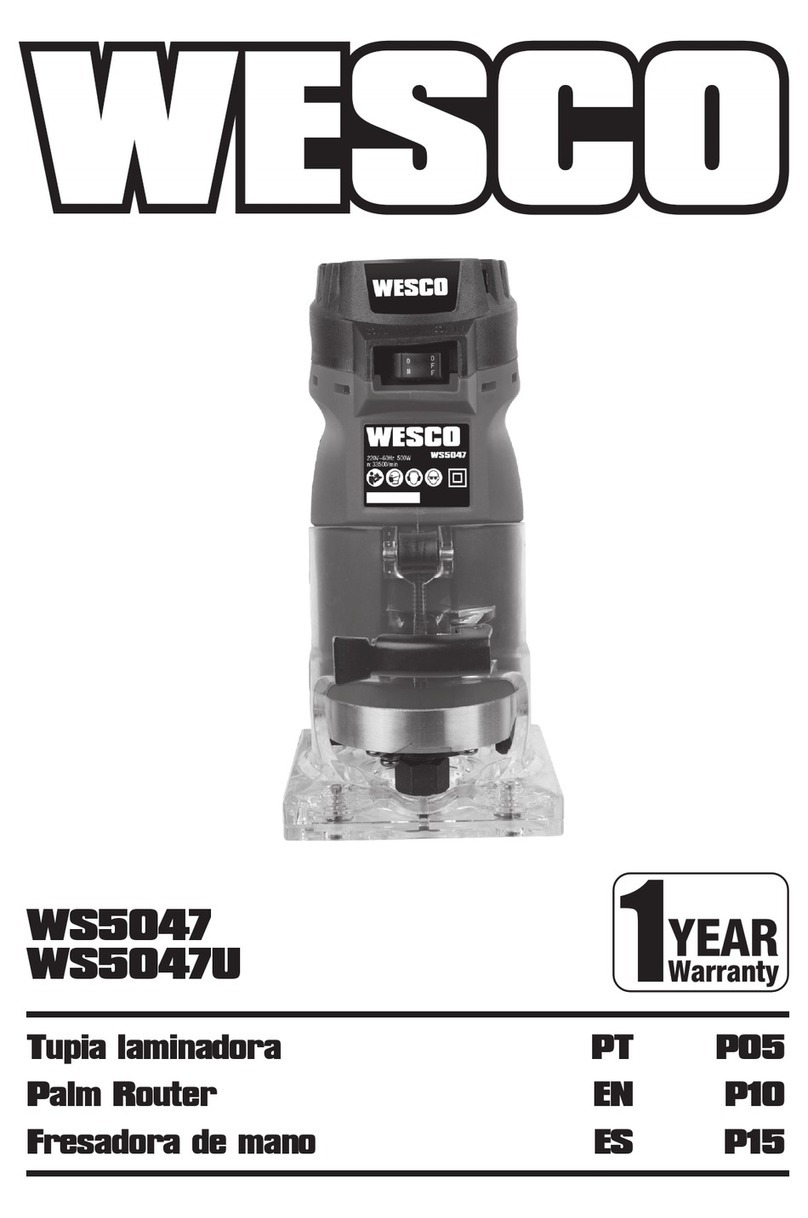Gechter 20 KHKP User manual

Operation Manual
Version 1.6 08/2009
P
NEUMATIC
T
OGGLE
P
RESSES
W
ITH
A
DJUSTABLE
G
UIDE
U
NIT
20 KHKP
60 KHKP

08/2009 Version 1.6
The original language of this document is German.
This is a translation of the original operation manual.
Document history:
Version Date Author Amendment/Reason for modification
1.0 02/09/2009 pfi Original version
1.5 05.2009 pfi Extended safety hints; notes; formatting; no actual figures!
1.6 08.2009 oge Actual figures, correct machine identification
GECHTER GmbH
Werkzeug- und Maschinenbau
Hannelore-Gechter-Straße 2
D-91074 Herzogenaurach
Telefon: +49 9132 7473 - 0
Telefax: +49 9132 7473 - 710
http://www.gechter.com
E-Mail: v[email protected]
This documentation is protected by copyright.
© 2009 GECHTER GmbH
All rights reserved

Operation Manual
Version 1.6 08/2009
Dear customer,
Congratulations to your new
press from our company. You
decided in favor of quality,
precision and service.
To describe operation and
maintenance as transparent
as possible we prepared this
Operation Manual with utmost
diligence. We would be
pleased to receive any sug-
gestions that you may have.
To always keep you informed
about our innovative press
program we would like to rec-
ommend you to take a look at
our Internet website or to send
your e-Mail address to
able us to keep you up-to-
date.
We wish you great success
and all the best for your com-
pany.
Your GECHTER team

08/2009 Version 1.6
This page was intentionally left blank.

GECHTER
– Pneumatic toggle presses
20 kN KHKP, 60 kN KHKP
Version 1.6 – 5 / 49 – 08/2009
Contents
1
About this manual ............................................................................................. 7
1.1
Target group.............................................................................................. 7
1.2
Validity....................................................................................................... 7
1.3
Warning notes and symbols....................................................................... 8
1.4
Other marks and symbols.......................................................................... 8
1.5
Trademarks ............................................................................................... 9
1.6
Disclaimer.................................................................................................. 9
1.7
Repository ................................................................................................. 9
2
Product description......................................................................................... 11
2.1
Overview ................................................................................................. 11
2.2
Design and intended use ......................................................................... 11
2.3
Scope of delivery ..................................................................................... 13
3
Safety................................................................................................................ 15
3.1
Person-related safety............................................................................... 15
3.2
Device-related safety............................................................................... 16
3.3
Inspection and maintenance.................................................................... 16
3.4
ZS control ................................................................................................ 17
3.5
Residual risks .......................................................................................... 18
4
Rules and regulations ..................................................................................... 19
4.1
Use for intended purpose ........................................................................ 19
4.2
CE marking.............................................................................................. 19
4.3
Standards and directives ......................................................................... 19
4.4
Disposal................................................................................................... 21
5
Mounting and commissioning ........................................................................ 23
5.1
Place of location ...................................................................................... 23
5.2
Transport of press ................................................................................... 24
5.3
Installation of press.................................................................................. 24
5.4
Pneumatic connection of press................................................................ 25

Operation Manual
08/2009 – 6 / 49 – Version 1.6
5.5
Electrical connection of press ..................................................................26
5.6
Switching on the press/acceptance test...................................................26
6
Installation........................................................................................................ 29
6.1
Place ram in basic position ...................................................................... 29
6.2
Remove clamping piece...........................................................................30
6.3
Adjust height............................................................................................ 30
6.4
Clamp tool ...............................................................................................32
6.5
Adjust stroke............................................................................................ 33
6.6
Fine tuning of height ................................................................................34
6.7
Adjust end position switch in top dead center (SEM control).................... 35
6.8
Setting pressure ......................................................................................36
7
Inspection and maintenance........................................................................... 37
7.1
Inspection/maintenance plan ...................................................................37
7.2
Greasing points ....................................................................................... 38
7.3
Pneumatic................................................................................................ 38
7.4
Control..................................................................................................... 38
7.5
Readjust adjustment gib ..........................................................................39
8
Troubleshooting .............................................................................................. 41
9
Technical data.................................................................................................. 43
9.1
Pneumatic toggle presses 20 / 60 kN KHKP ............................................ 43
9.2
Dimensional drawings.............................................................................. 45
10
Available models, spare parts and accessories ............................................ 47
10.1
Available models......................................................................................47
10.2
Accessories ............................................................................................. 47
10.3
Spare parts..............................................................................................48

GECHTER
– Pneumatic toggle presses
20 kN KHKP, 60 kN KHKP
Version 1.6 – 7 / 49 – 08/2009
1 About this manual
1.1 Target group
This manual is addressed to qualified specialized staff having the technical skills
and expertise for mounting and commissioning as well as setting and installing of
presses.
1.2 Validity
This manual is valid for the following products:
Pneumatic toggle presses 20 KHKP and 60 KHKP,
with a series no. 301xxx (20 KHKP) or 81xxx (60 KHKP), and a year of manufac-
ture 2009;
each with extended throat and/or extended daylight and/or stroke extension as
well;
each with a press safety control ES06 or ZS06 (ZS06, -F, M, -FM) (→page 47,
Accessories) as well.
The controls are described in their own Operation Manuals each. For presses
equipped with a control, the Operation Manual is an integral part of the Operation
Manual of the complete machine.
An additionally mounted MS00 measuring system (→page 47, Accessories) in
the ZS06M or ZS06FM controls is described in the Operation Manual of the
MS00 Measuring System. For presses equipped with a MS00 measuring system,
the operation manual of the MS00 measuring system is an integral part of the
operating manual of the complete machine.

Operation Manual
08/2009 – 8 / 49 – Version 1.6
1.3 Warning notes and symbols
In this manual the following marks for safety instructions will be used:
WARNING!
TYPE OF RISK will be named
Warning refers to a danger, which in case of non-observance can lead to severe
injuries or in extreme cases to death.
Please adhere to the measures stated to avoid hazardous situations.
CAUTION!
TYPE OF RISK will be named
Caution refers to a danger, which in case of non-observance can lead to slight or
medium injuries.
Please adhere to the measures stated to avoid hazardous situations.
NOTE
Note refers to a danger to property damage, without any danger to health or life.
1.4 Other marks and symbols
Depending on the textual content the following marks will be used:
Identification of instructions on how to act
Identification of numerations
→Page xy cross reference to other text passages in the manual
Additional information
for optimum use and setting of devices as well as other
useful notes.

GECHTER
– Pneumatic toggle presses
20 kN KHKP, 60 kN KHKP
Version 1.6 – 9 / 49 – 08/2009
1.5 Trademarks
All designations labeled with a trademark note
®
are registered trademarks of the
respective owners. All other designations in this document may be trademarks
whose use by other parties for their purposes might violate the rights of the own-
ers.
1.6 Disclaimer
We checked the contents of this document for consistence with the described
hardware and software. Nevertheless discrepancies cannot be excluded. There-
fore we do not accept any liability for the correctness. The information given in
this document is regularly checked, necessary correction can be found in the fol-
lowing editions.
This Operation Manual contains a description of the product (→Validity) valid at
print date. It is exclusively meant for descriptive purposes to support commission-
ing and operation of the product. Guaranteed characteristics of the product, par-
ticularly the suitability for a specific intended use, cannot be derived herefrom.
The specifications in this manual can change at any time without prior notifica-
tion. GECHTER GmbH reserves the right to improve and to change the product
for the purpose of technical progress without the obligation to inform persons and
organizations as the result of such changes.
1.7 Repository
Please keep this manual always easily accessible in the close environment of
your device. The manual must be available for the operator during operation of
the machine at any time.
At transfer, sale, rental, etc. of the press, this operation manual must always be
delivered with the press.

Operation Manual
08/2009 – 10 / 49 – Version 1.6
This page was intentionally left blank.

GECHTER
– Pneumatic toggle presses
20 kN KHKP, 60 kN KHKP
Version 1.6 – 11 / 49 – 08/2009
2 Product description
2.1 Overview
(1)
(2)
(3)
(4)
(5)
(6)
(7)
(8)
(9)
Fig. 1 Overview linear acting pneumatic presses
(1) Stroke adjustment
(2) Press cylinder
(3) Guide unit
(4) Door with key
(5) Tool fitting
(6) Press table
(7) Position switch
(8) Height adjustment
(9) Press stand
2.2 Design and intended use
Pneumatic toggle presses are by design especially suited for works that need
high forces shortly before the end of the stroke. They are therefore mainly suited
for embossing, riveting, punching, cutting, mounting, and bending works. The
advantage of the toggle principle is the fast execution of the approach stroke and
the slow execution of the power stroke. By this, the material is allowed to adapt to
the tool. This is particularly important for materials as aluminium or brass.
As opposed to the linear acting pneumatic presses which have a constant force
over the complete stroke, the pneumatic toggle presses have a typical force
curve, where high forces only occur at the lower range of the stroke. Neverthe-

Operation Manual
08/2009 – 12 / 49 – Version 1.6
less, a high force is effective, the final pressure builds up continuously and pre-
cise works can be executed with these presses. This helps with working of thin
materials especially.
At the toggle presses, approach and force stroke are accomplished by means of
the toggle link, which is actuated by a pneumatic cylinder according to the trans-
mission. The main advantage of this design is the achievement of high forces at a
relatively low compressed air consumption.
The presses are exclusively intended for cold working of metal or other sheet
material (e.g. cardboard, plastic, rubber, leather) and metal powder. They are
especially not suited for the use of material that can generate splinters at applica-
tion of pressure or cutting (composite material, acrylic glass etc.).
NOTE
The presses are exclusively intended to be used as technical working equipment
to accomplish the said types of work in the commercial or industrial area by
trained and skilled staff.
Any other use
, especially by private consumers, or use exceeding that specified
is an infringement of use for intended purpose.
The long stroke force of 60 mm of these machines requires appropriate safety
devices to eliminate risks of injury (e.g. the use of a safety control).
With the appropriate controls the presses can be used starting at the single-user
workstation (inserting operations) to the fully automatic machine (rotary table with
feed and take stations). They can be used for almost every use of operation
within the technical limits of the machine.
Due to the little physical use of force even large-scale mass productions can be
carried out with these presses, demanding only a constant work strain for the
operator.
With a maximum operating pressure of 6 bar the presses reach their nominal
power, but they can also be operated with correspondingly lesser pressure down
to approx. 3 bar with a proportionally decreasing force. They can optimally be
adapted to the operating procedure due to manifold adjustability and positioning
possibilities.

GECHTER
– Pneumatic toggle presses
20 kN KHKP, 60 kN KHKP
Version 1.6 – 13 / 49 – 08/2009
2.3 Scope of delivery
Before mounting/commissioning please check delivery for completeness and in-
tactness. In case of parts missing or showing visible damages please inform
GECHTER
GmbH.
Quantity Art. No. Description
1 D3***.001
or D7***.001
Pneumatic toggle press, mounted ready for use
Option-
ally 1
X****.*** ES, ZS, or SEM control as ordered, complete with two-hand control
box, safety valve block and service unit
1 This Operation Manual (for EU countries national language
additionally)
Tab. 1 Scope of delivery

Operation Manual
08/2009 – 14 / 49 – Version 1.6
This page was intentionally left blank.

GECHTER
– Pneumatic toggle presses
20 kN KHKP, 60 kN KHKP
Version 1.6 – 15 / 49 – 08/2009
3 Safety
Before mounting/commissioning and the use of this product this manual must be
read carefully.
Special attention must be paid to the following notes of this chapter as well as to
the safety notes of the manual. Compliance with these notes is a premise for a
safe workflow.
3.1 Person-related safety
WARNING!
Basic safety measures
Only trained and skilled staff is allowed to work on the machine!
Except for the operator no other person is allowed to work on the machine!
The door at the front of the guide unit (→Fig1, (4)) must always remain
closed when operating the press!
Before opening the control box always switch off the main switch and
disconnect the device from the electric current (disconnect mains plug)!
When working on the press, e.g. tool change, the press must be
disconnected from the compressed air supply if possible (using manual slide
valve, →page 25, Pneumatic connection of press).
CAUTION!
Avoidance of crushing dangers
The predominant part of press accidents is caused by the movement of press
tools or parts of press tools. This leads to finger and hand injuries.
To avoid these
dangers the following measures must be taken:
For operations in the operating modes with foot switch exclusively "safe
tools" according Table 4 of EN ISO 13857:2008 and Table 1 of EN 349:1993
may be used!
Pay attention that no parts of the body enter the tool area during operation!
The tool area is the main hazardous area of the press.
When setting the press observe the minimum distances to avoid crushing of
body parts (EN ISO 13857:2008 and EN 349:1993)! The safety distance
indicated on the type plate must be observed.
When using the press for manual feeding operations a two-hand safety
control must be used!

Operation Manual
08/2009 – 16 / 49 – Version 1.6
Behavior in case of emergency
In case of a hazardous situation immediately press the red emergency stop
button of the press control!
If a person is stuck in a tool and at the same time the emergency stop button at
the bottom dead center of the press is activated it can happen that the person is
captured. To release the captured person, proceed as follows:
Release red emergency stop button.
Switch on control voltage (green illuminated pushbutton "On").
The ram moves back and the captured person can be released.
In an extreme emergency the press tool must be opened with a crowbar.
Instruction/training of operating personnel
The operators must be instructed about the dangers that can occur regarding
their activities as well as about measures of prevention before taking up their ac-
tivities and after this in appropriate intervals but at least once a year. It is recom-
mended to keep records on these instructions and to store these records in a
suitable place.
For presses delivered with a control a check list for check of safety must be
available that can be signed by the inspector (→Operation Manual of the con-
trol).
3.2 Device-related safety
The press requires a safe stand and rugged mounting (→page 24, Installation of
press).
The operating pressure of the press may not exceed the permissible maximum
(maximum operating pressure →page 43, Technical data)!
Otherwise increased wear or demolition of components might result.
3.3 Inspection and maintenance
Before use of the device the user must assure that all safety-relevant parts of the
device are working properly and that the device is ready for use.
To maintain operational safety and functional capability of the product a regular
inspection and maintenance depending on the degree of utilization is necessary.
Please observe the relevant explanations (→page 37, Inspection and mainte-
nance).

GECHTER
– Pneumatic toggle presses
20 kN KHKP, 60 kN KHKP
Version 1.6 – 17 / 49 – 08/2009
When parts are exchanged within the scope of repair works, for safety reasons
only original parts must be used. Repair works must be carried out by appropri-
ately qualified GECHTER GmbH personnel.
3.4 ZS control
When operating the press with a ZS control, the observation of the following is
mandatory (see also Operating Manual of the ZS control):
3.4.1 Two-hand operation with muting
Two-hand operation with muting of the ZS06 and ZS06M controls, that is the op-
eration mode in which the press remains in bottom dead centre wihout two-hand
buttons being pressed any longer, and the press returns to top dead centre after
an adjustable holding time has elapsed, is allowed only under the following pre-
conditions:
•
••
•
Additionally to the sensor "press in b.d.c." the sensor "tool closed" must be
present and installed with expertise. This sensor is used for safe muting. It
has to be mounted at or in the tool by the customer in such a way that it is
actuated depending on the displacement when the tool is closed resp. when
the opening gap of the tool is less than 6 mm. The sensor is monitored dy-
namically, i.e. it ts checked if the sensor signal changes on each press
stroke.
•
••
•
The return stroke is "safe", i.e. that during the return of the press ram from
b.d.c. to t.d.c. (return stroke) no danger areas may exist or be generated.
This has to be assured by the dimensions of the tool (→page 43, Technical
data) or by an appropriate cover.
3.4.2 Foot mode
The foot switch operation mode with the ZS06F and ZS06FM is only allowed with
"closed tools" with an opening gap of < 6 mm all around.
The other prerequisites are the same as with operation mode "two-hand opera-
tion with muting", i.e. the sensor "tool closed" must be present and installed with
expertise and the return stroke must be "safe" as well.

Operation Manual
08/2009 – 18 / 49 – Version 1.6
3.5 Residual risks
Even when adhering to the safety measures mentioned there are residual risks
when using the device:
During maintenance and servicing with switched off air supply the ram can
fall. Therefore, before start of work an appropriate support has to be inserted
into the tool which will be able to carry the maximum press force of the press.
Because the tool will be designed by the customer it is not possible for the
manufacturer to provide a fixture.
Due to longer switch off of the air and power supply it can happen that the
ram falls. When switching on the air and power supply the press moves back
to the top dead center. Therefore, increased caution is necessary when
switching on the control voltage!
The maximum allowable area for mounting tools is defined by the dimen-
sions of the press ram. In this case, the return stroke is safe, i.e. no danger
areas are present during the upward movement of the ram. Tools with bigger
dimensions are only allowable if additional covers (not included in the scope
of delivery) that ensure a safe return stroke are used.
If tools are used that exceed the dimensions of the press stand table, in-
creased caution is necessary and the operator has to make sure that no
crushing hazard is generated between the tool and the C-stand of the press.
This is necessary especially for presses with extended throat stand. Here, no
constructive measure by the manufacturer is possible.
Additional safety measures may be necessary to minimize the exposure of
the operator to hazardous materials which might originate during processing.
Since these materials are not defined the necessary measures cannot be
dealt with in this manual.
Depending on the use of the press additional measures to reduce fire and
explosion hazards as much as possible might be necessary. When using
flammable matters EN 1127-1 indicates guidelines.

GECHTER
– Pneumatic toggle presses
20 kN KHKP, 60 kN KHKP
Version 1.6 – 19 / 49 – 08/2009
4 Rules and regulations
4.1 Use for intended purpose
The linear acting pneumatic presses may exclusively be used for pressing, as-
sembling, mounting, riveting, punching, bending, embossing and cutting opera-
tions.
NOTE
The presses are exclusively intended to be used as technical working equipment
to accomplish the said types of work in the commercial or industrial area by
trained and skilled staff.
Any other use
, especially by private consumers, or use exceeding that specified
is an infringement of use for intended purpose.
The presses are exclusively intended for cold working of metal or other sheet
material (e.g. cardboard, plastic, rubber, leather) and metal powder. They are
especially not suited for the use of material that can generate splinters at applica-
tion of pressure or cutting (composite material, acrylic glass etc.).
The presses are not intended for use in areas where the danger of explosions
exists or in areas with increased hygienic demands (e.g. pharmaceutical areas,
groceries) and therefore must not be used in such areas.
4.2 CE marking
The EU machinery directive harmonizes the demanded characteristics and im-
plements a conformity process for machines. Among others this means a stan-
dardization of the basic safety and health requirements for the design and con-
struction of machines.
The presses for which this manual is valid (→page 7, Validity) comply with the
requirements of the appropriate European directives.
Conformity was proven. The necessary documentation for this is left with the
manufacturer.
A copy of the conformity declaration
will be delivered with each individual press.
4.3 Standards and directives
The following, possibly harmonized standards and directives have been applied
during development and construction of the presses:

Operation Manual
08/2009 – 20 / 49 – Version 1.6
Standard Version Title
98/37/EG 1998 Machinery directive
2006/95/EG 2006 Low voltage directive (only for presses with a control)
2004/108/EG 2004 EMC directive (only for presses with a control)
9. GPSGV 2008-06 9. Verordnung zum Geräte- und Produktsicherheitsgesetz (Maschinenverordnung)
(for Germany only)
EN 349 2008-09 Safety of machinery. Minimum gaps to avoid crushing of parts of the human body
EN 574 1997-02 Safety of machinery - Two-hand control devices – Functional aspects – Principles for
design (only for presses with a two-hand control)
EN 983 1996-09 Safety of machinery. Safety requirements for fluid power systems and their
components. Pneumatics
EN ISO 12100-1 2004-04 Safety of machinery - Basic concepts, general principles for design - Part 1: Basic
terminology, methodology
EN ISO 12100-2 2004-04 Safety of machinery - Basic concepts, general principles for design - Part
2: Technical
principles
EN 13736 2003-07 Safety of machine tools – Pneumatic presses
EN ISO 13849-1 2007-07 Safety of machine tools – Safety-related parts of controls – Part 1: General design
guidelines
(
only for presses with a control)
EN ISO 13857 2008-06 Safety of machinery -- Safety distances to prevent hazard zones being reached by
upper and lower limbs
EN 14121-1 2007-12 Safety of machinery. Risk assessment. Principles
EN 60204-1 1998-11 Safety of machine tools – Electrical equipment of machines – Part 1: General
requirements
EN 61062 2005-10 Safety of machinery - Functional safety of safety related electrical, electronic and
programmable electronic control systems
Tab. 2 Directives and standards
As an operating company of the press you are responsible to observe all safety
measures and instructions which can, among others, be found in the following
standards and directives:
Standard Version Title
BGV A1 2000-08 Grundlagen der Prävention (for Germany only)
BGR 500 2004-10 Betreiben von Arbeitsmitteln (for Germany only)
EN 1837 1999-03 Safety of machinery. Integral lighting of machines
Tab. 3 Directives and standards
Further instructions and/or standards may apply depending on use case or loca-
tion. In the instructions and standards mentioned there may to some extent be
reference to other instructions or standards that might also have to be taken into
consideration if need be.
This manual suits for next models
3
Table of contents
Other Gechter Power Tools manuals
Popular Power Tools manuals by other brands
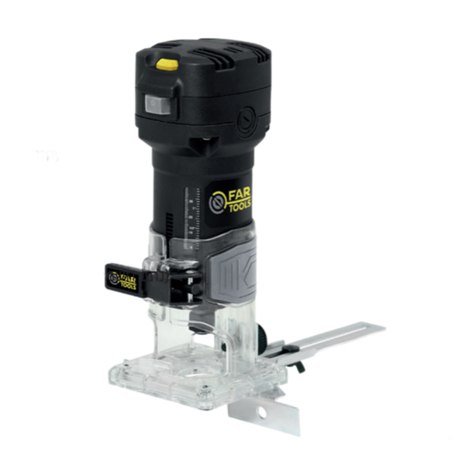
Far Tools
Far Tools AE 850 Original manual
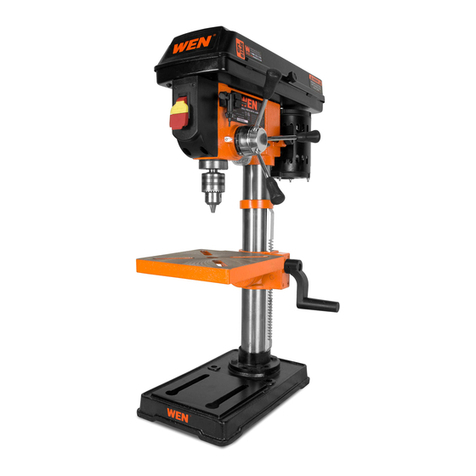
Tack life
Tack life TKDP01A user manual
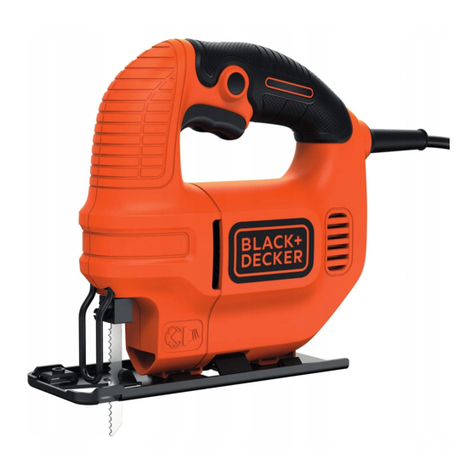
BLACK DECKER
BLACK DECKER KFBES410 manual

Chef's Choice
Chef's Choice Ceramic + Steel 700 instructions

Central Pneumatic
Central Pneumatic 46446 Assembly and operating instructions
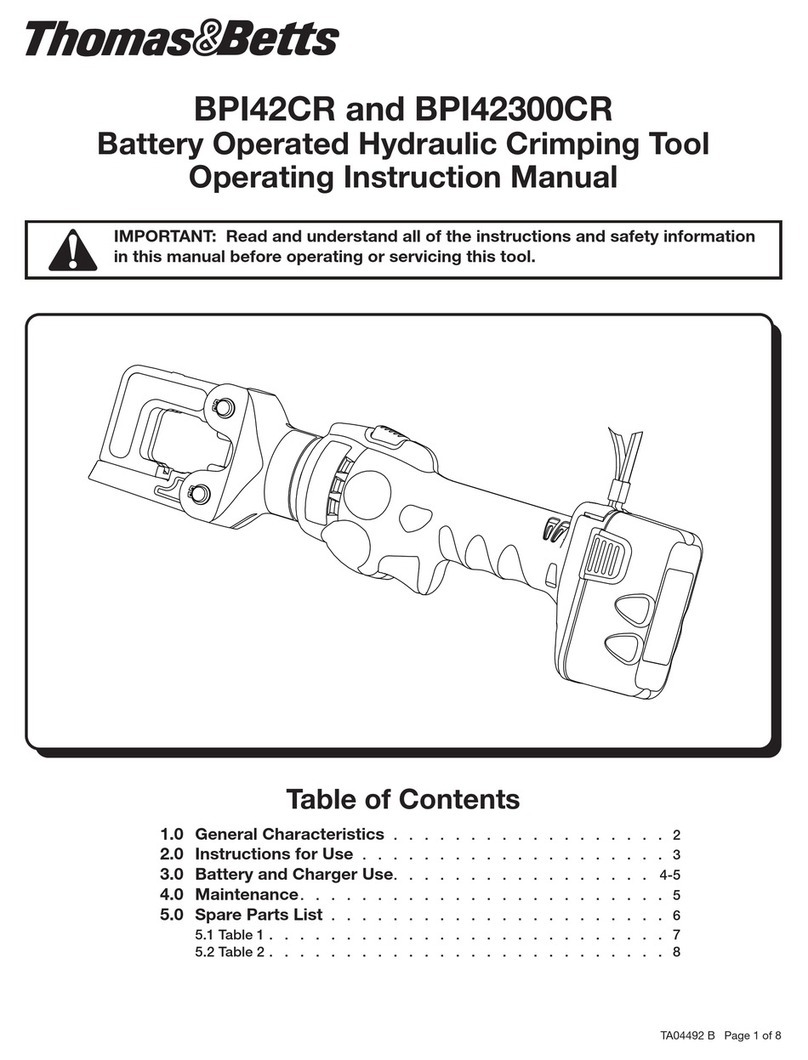
Thomas&Betts
Thomas&Betts BPI42CR Operating instructions manual
